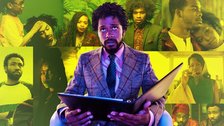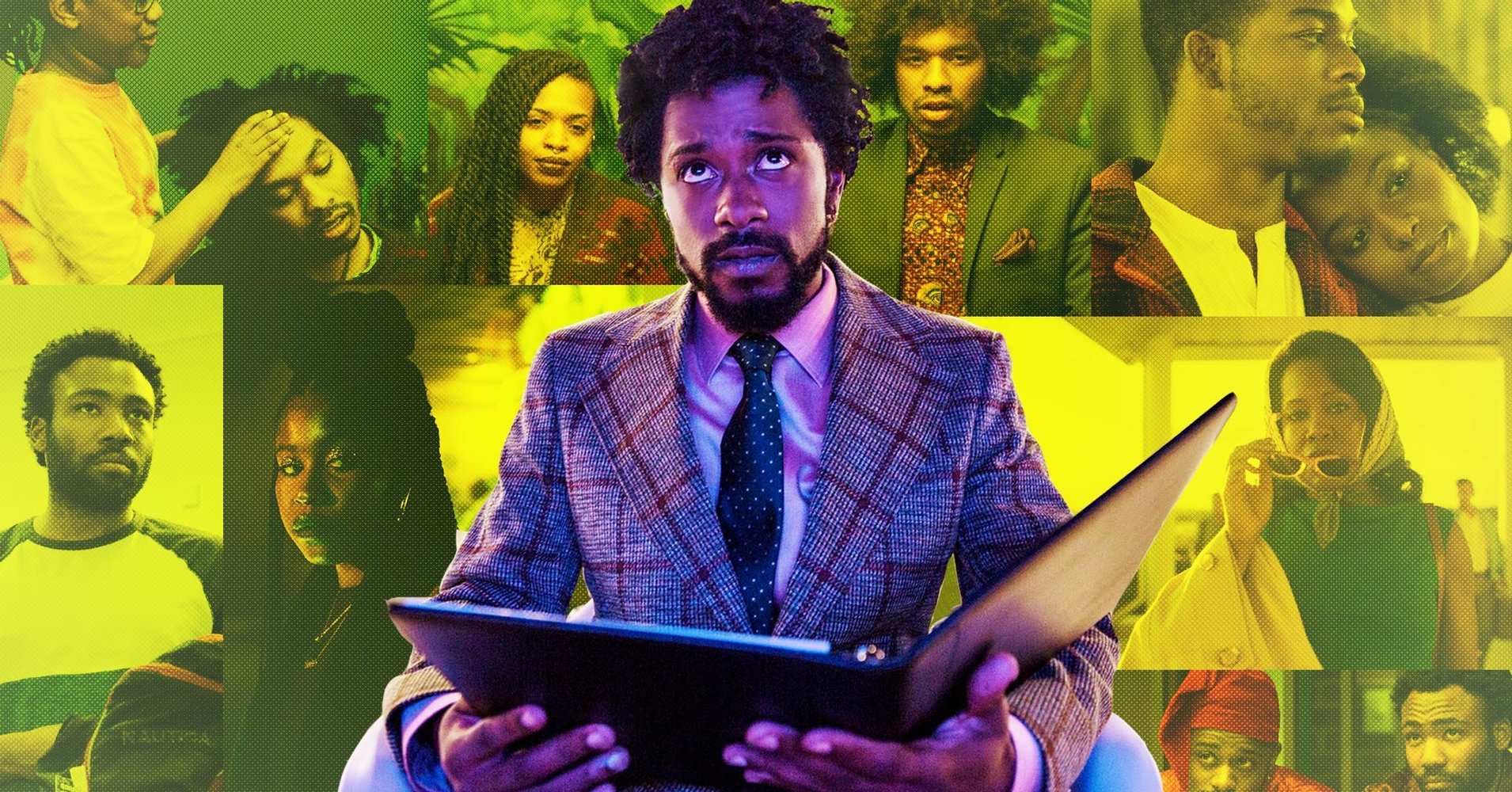[ad_1]

In “Sorry to Bother You,” chaos fills the screen. Cash, on the first day of his new telemarketing job, makes his first call. Someone picks up. Suddenly, he’s falling out of his cubicle in some gray office building, directly into the home of the person he’s calling, whereupon he starts pitching the guy from across his breakfast table. In another scene, a riot breaks out on the streets of Oakland, where eight-foot-tall horsemen clash with police. It’s beautiful clutter.
Boots Riley, a musician and the writer-director of the film, put me onto the idea of beautiful clutter this year. Beautiful clutter, according to him, is the primary aesthetic of the surreal, absurdist adventure that was his film about a down-on-his-luck dude (played by Lakeith Stanfield) who moves up in the telemarketing world thanks to an ability to code-switch into the perfect “white voice.”
Riley’s influences cover the cultural map, from the artwork of Romare Bearden and Jacob Lawrence to the funk music of George Clinton to novelists like Toni Morrison and Gabriel García Márquez — artists who he said capture a sense of things “stacked and layered upon each other,” a feeling of “roughness and raggedy,” “some aggression, some messiness,” something with the coarse thickness of life itself.
Riley makes beautiful clutter just talking about beautiful clutter. Here’s how he described it to me in an interview:
There are writers that are great writers, and then some of them might be a little bit more basic. They might say, “He walked to the store.” But someone like a Toni Morrison might be like, “He walked slowly to the store, holding in his left hand the cup that his grandmother had, 20 years before, murdered his grandfather with. In the cup was the coffee from last night that he was doggedly determined to finish.” Or something like that.
Cinematically, most producers would say, “Don’t even say he walked to the store, just show him at the store.” Right? And many times they’re right. I’m not saying that there’s a wrong way to do it, but when you do that, then all of a sudden, 10 pages later, you find yourself in a situation where now you’re forcing someone to say, you know, that 20 years ago his grandmother murdered his grandfather. You’re sitting there thinking they’ve been knowing each other all their lives, why are they saying is now? So there’s ways to put information in that makes you reflect off of things and gives meaning to things. And so that, that sort of literary thing is what I was going for aesthetically. … I wanted [the movie] to feel cluttered and beautiful and, I mean, like real life is.
Riley sees this as a quintessentially black aesthetic, and 2018 bore him out. This was the year of beautiful clutter in black TV and film. It was the year that gave us TV shows like “Random Acts of Flyness” and “Atlanta: Robbin’ Season,” movies like Riley’s, “BlacKkKlansman” and “If Beale Street Could Talk.” I’m thinking in particular of the hazy memories and layered soundscape in “Beale Street,” the frenetic energy of “Random Acts,” the “Twin Peaks”-by-way-of-Buckhead weirdness of “Atlanta.” In their mix of surrealism, satire and languid nonconformity, all these projects marked if not a shift in black filmmaking, then at least an embrace of a different, more challenging, more cluttered approach to themes of race and black identity.
It used to be that mainstream movies that addressed race in any way tended to be somber affairs centering the emotions of the white audience. The tone of these movies flowed from that emphasis on white feeling: They were straightforward, paint by numbers, rooted in a sanitized vision of American life, presented in the style of the kind of prestige filmmaking designed expressly to catch the attention of all-white awards academies.
It used to be that mainstream movies that addressed race in any way tended to be somber affairs centering the emotions of the white audience.
In these movies, good white liberals either needed to be congratulated on their goodness or shocked into appreciating the brutality of racism. These were movies like “To Kill a Mockingbird,” “Amistad,” “The Help” — movies that, if they explored black life at all, explored it through the perspective of whiteness.
The popularity of “The Green Book” testifies to the durability of the genre’s appeal. But the difference is that in 2018, Peter Farrelly’s buddy road movie had to sit uncomfortably alongside all the offerings from black directors, movies that were pitched to the sensibilities of black audiences without making any allowances for the feelings of white filmgoers, that were unconcerned with how white audiences might receive the weirdness of the work. These movies call on a rich history of Afro-surrealism, Afro-futurism, Négritude, traditional African art and the black avant-garde. In “Random Acts of Flyness,” creator, director and star Terence Nance is confronted by a white police officer and, instead of the seemingly inevitable burst of violence, he flies away. In “Beale Street,” the music of Miles Davis is layered upon the sounds of New York City, the sound of the subway, over images of Tish’s dreams and memories of her first time with Fonny — a rich visual and auditory landscape of black life. The bizarre and transcendental hover at the edges of the real and mundane.
“I think we all just make hypersubjective work, and we’re all black, so … we’re not one thing, you know? We represent just very specific and subjective iterations of blackness globally,” said Nance. “Definitely not just in America, but we represent a lot of different places, environments, migratory, transient experiences within and around the diaspora.
“Our first audiences is each other. Our first audience is ourselves. And we don’t have to look outside of that to feel engaged and feel inspired to feel kind of aligned with the ideas, the concepts, the feeling of making and the joy of making stuff for each other. We aren’t thinking about avoiding the need for that. I don’t think we would know how to make something quote unquote for white people. We’re not white, so we don’t know.”
There was a lesson to be gleaned from all the beautiful clutter: Concerns about representation in Hollywood don’t exist apart from aesthetic considerations. The past year was a great case study in the explosion of creativity, the broadening and deepening of theme and approach, that can ensue when filmmakers are liberated from the burden of being the Only One. With more new voices came more potential for new aesthetic approaches. Black cinema in 2018 revolved less around “look at the bullshit we went through” and delved more into questions of ramifications: How does this bullshit manifest itself in the workplace, in family dynamics, in sex?
Black filmmakers are freer to experiment with tone, with genre, with perspective, freer to speak to black audiences, freer to move beyond the question of white people altogether. It’s no accident that they have tended to coalesce around the surreal, an aesthetic that lends itself most to experimentation and that mirrors the absurdity and unreality of black life.
Some artists, like Spike Lee, struggle with this freedom. (In “BlacKkKlansman,” based on the true story of a black police officer who infiltrated a chapter of the KKK, Lee still clings to some of the familiar tropes of visual storytelling, even as he plays for the first time with time and perspective.) Others, like Nance, have wholly embraced it.
Black filmmakers are also freer to challenge one another and be challenged. This year, Riley was called out for the one-dimensional nature of Detroit, the sole female lead in “Sorry to Bother You.” (His response was defensive, to say the least.)
Later he shared his thoughts in a three-page letter posted to Twitter about Lee’s flawed but exciting “BlacKkKlansman,” which Riley critiqued as consisting of “untrue elements that make a cop a hero against racism.”
“For Spike to come out with a movie where a story points are fabricated in order make Black cop and his counterparts look like allies in the fight against racism is really disappointing, to put it very mildly,” Riley wrote.
A few days later, Lee tacitly responded to these critiques in an interview with The Times of London. “I’m never going to say all police are corrupt, that all police hate people of color,” he said. “I’m not going to say that. I mean, we need police.”
The back-and-forth itself isn’t much. But the fact that Lee, for so long the Only One, was being challenged in this way by another filmmaker who isn’t Tyler Perry was remarkable. That it unfolded outside of the good-Negro-bad-Negro paradigm that white America has historically foisted on black cultural figures was monumental.
Black filmmakers are freer to experiment with tone, with genre, with perspective, freer to speak to black audiences, freer to move beyond the question of white people altogether.
All the old dichotomies could now be scrutinized. “Beale Street” director Barry Jenkins spoke of the long-standing tension for black filmmakers between a responsibility to make an argument and a dream of making art that soars beyond didacticism — “this idea,” he said, “that if I’m making an art film, then I have to completely divorce myself from the idea that I’m making something that’s a cultural work or something that has, I’ll be more honest, something that has a cultural responsibility.”
He rejected the notion that these two things have to be in tension. “What I don’t feel like is that if something has a cultural responsibility, then it can’t be an uncompromised work of art,” he said. “And so it’s something I try to take off the table and disregard.
“Every artist wrestles with it, but I do say, and maybe I shouldn’t say this, but for black artists, it’s something that we have to wrestle with in particular,” Jenkins added. “And for a female artist, something that they have to wrestle with in particular as well, because there’s such a lack of the stories that we’re telling. And now we’re filling that lack, we’re filling that void. And so maybe down the line, the tension between the two won’t be as prevalent.”
When Jordan Peele’s “Get Out” was released in 2016, there was a lot of debate about how to categorize it. People argued about whether it was a horror movie, a comedy, a drama. Then the Golden Globes Best Musical or Comedy nomination happened, only fueling the debate. Much of that confusion comes from the way we’ve been taught to view black films: that they are inherently niche, that while white-led movies fall into a basic, varied catalog of genres, black movies are a genre unto themselves.
“Get Out” not only took on a genre many people mistakenly think can’t be used as social commentary but also challenged and subverted the tropes of that genre. By doing so, it disarmed an audience that has been socialized to think that black films are only period films and biopics or Tyler Perry melodramas and that horror can’t be used to elevate discussions about race.
Two years after “Get Out,” this potential is becoming abundantly clear. The recently released trailer for Peele’s “Us” suggests that black filmmaking is continuing to take bold, interesting and, most of all, surreal new routes in telling black stories.
There has always been an expectation for black art to be challenging and easy, to ask the tough questions but also to provide the reassuring answers. Things are trickier now, messier. The beautiful clutter of 2018 tells us that the old model has been confounded.
“What is art supposed to do?” Riley said. “Hopefully, there’s an optimistic outlook that people come away with. But it doesn’t have to be a pleasant experience. It’s not easy-listening jazz.”
[ad_2]
Source link

